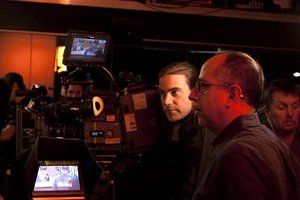
Franco Di Chiera’s feature Big Mamma’s Boy is the most recent portrayal of the Italian community in Australia to be committed to film. Miguel Gonzalez spoke with the director about the influence of Italian pioneer Giorgio Mangiamele and the unlikely connections between their work.
Giorgio Mangiamele was the first Italian director to work in Australia, and yours is the most recent feature made by an Italian Australian. Can you find any connections between Mangiamele’s first film and your latest?
Mangiamele was ahead of his time. In Il Contratto (1953), he showed the struggles of Italian contract workers living in Australia, so he was dealing with labour relations all the way back in the 1950s. It wasn’t until the 1970s and ’80s and works such as Sunday Too Far Away (1975) and Strikebound (1983) that the Australian industry really dealt with these issues.
To me, the images in his films are quite symbolic of that migrant experience, of the sense of dislocation and the gap between generations.
He was one of the first people to explore the migrant experience on screen, as well as intercultural relationships, and I’m continuing that tradition. Also, we were both inspired by Italian neo-realism. My film The Joys of the Women (1993) is about a group of native Italian women in Perth, and an Italian-Australian who wants to keep those traditional songs alive and document these culture vestiges through music. Big Mamma’s Boy is a romantic comedy, but in a way it is also about the migrant experience, the clash of generations. The Mamma represents the value system of those postwar migrants that came to Australia in the 1950s, and Rocco represents that first generation, born and raised here. Of course, they’re going to clash.
How did you first discover Mangiamele’s work?
In 1988 I was the producer and supervising director of a three-part documentary series for SBS, called A Change of Face (1988), which challenged notions of Australian identity, as well as ethnic stereotyping on Australian screens from the early days of the industry to the late 1980s. One of the directors on that project was Luigi Acquisto, whose short Spaventapasseri (1986) was nominated for four AFI Awards. In the process of making that series, Acquisto found some of Mangiamele’s films and we included them in the documentary. It really blew my mind that this guy existed, because people had forgotten about him.
Is his work well-known in the Italian-Australian community?
His work is being rediscovered. Often people who are greatly misunderstood or ahead of their time are not given the credit they deserve. It’s interesting that Mangiamele is now getting that credit.
He was a true artist in the sense that he made films because it was his passion, and then it was a bonus if other people got to enjoy and appreciate them. He wasn’t someone who went out trying to make a commercial film, but he achieved great recognition when Clay (1965) went to Cannes. Strangely, rather than catapulting his career, it seems to have died for some time; he didn’t make another film for five years after that, and that would be his last (Beyond Reason, 1970).
In the end it comes down to the integrity of storytelling. Mangiamele’s films certainly did touch people; they may not have been widely known, but they got the recognition in their day and they’re getting it again now.
The press hasn’t been very generous with Big Mamma’s Boy, but audiences seem to have embraced it. Why do you think opinions are so polarised?
It’s an interesting dilemma that critics’ views of a film can be quite different from an audience’s experience of it. It’s no wonder that so few comedies, and even less romantic comedies, get made in this country. Regardless of what people may say about The Wog Boy (2000) and its sequel, they work with their audience.
Although ours is a different sort of film, it is also a comedy and, obviously, we make use of stereotypes like most comedies do. Since the story takes place within an ethnic community, people can be a bit politically correct about that. My argument is that if we left it at a level of stereotype, with one-dimensional characters, the criticisms would be valid, but I do believe that these characters go beyond that and, in the end, they’re well-rounded and have an emotional impact on the audience.
Big Mamma’s Boy is currently showing in cinemas across Australia. Giorgio Mangiamele’s films Il Contratto (1953), Ninety Nine Per Cent (1963), Clay (1965) and two versions of The Spag (c1960 and 1962) have recently been restored by the National Film and Sound Archive and are available on DVD through Ronin Films.


